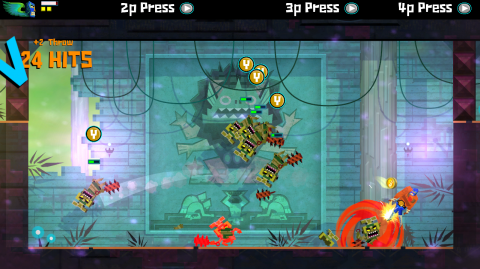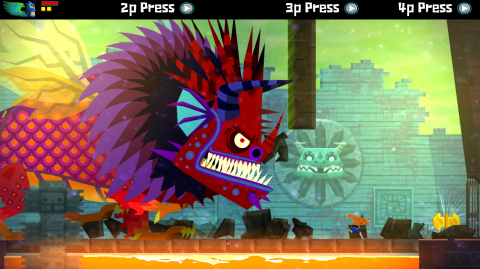- Guacamelee!
- Guacamelee! 2
Metroidvanias can be difficult to keep fresh, especially given the many, many stabs at the genre people have made over the years. Some do their best to try and vary themselves up, including things like adding the third dimension, or RPG elements. Unfortunately, despite their efforts, many of them feel quite similar, which is especially bad in a scene where you’re meant to wander back and forth across a massive, unchanging maze, gathering up the same sorts of abilities in different coats of paint. That’s why Guacamelee! is such a surprise. It manages to keep itself unique, and does a far better job at it than plenty of other games it’s sharing the genre with.
You take the role of Juan, a simple agave farmer with a childhood crush on El Presidente’s beautiful daughter. Unfortunately, she soon ends up being captured by the evil Carlos Calaca, who plans to use her in his schemes to rule the worlds of the living and the dead. It then follows that Juan ends up toasted by Calaca about 10 seconds after encountering him. Thankfully, however, he comes across a powerful luchador’s mask within the realm of the dead that restores him to life, and grants him a bunch of sweet wrestling moves in the process. Joined by Tostada, the guardian of the mask, Juan sets off on his fateful quest to find and defeat Calaca. Of course, that’s only after he acquires a series of abilities that’ll let him get rid of the color-coded obstacles in his way.
It isn’t too long after Juan acquires the mask that the game begins to set itself apart from other Metroidvanias, primarily through its focus on combat. Guacamelee! is just as much a brawler as it is a platformer, and it might be the most combat-heavy Metroidvania you’ll see, short of Shadow Complex. Juan starts off with a three-hit combo that can be done from the ground and in the air, an uppercut for starting juggles, and a downward smash to bring enemies back to earth. The most interesting moves of all, however, are the throws you can perform once you’ve hit most enemies enough times. You can chuck them in any direction to plow through other foes, boot them across the screen, or simply piledrive them for major amounts of damage.
The game is clearly proud of its combat, since it frequently locks you into rooms where you have to take out waves of enemies. Thankfully, the battle systems manage to remain fun and frantic throughout. It always feels incredibly satisfying, like the split-second pause when you successfully dodge roll through an attack, or watching your combo counter build up as an enemy you toss knocks its way through a crowd of foes.
There are plenty of times where you’ll end up with enemies all over the screen, which makes weaving around them and taking them all out in one big clump incredibly satisfying. Even though the basics of combat are pretty simple, there’s still a fair amount of depth in the way you can extend your combos, like aforementioned dodge roll, which lets you follow after an enemy you’ve knocked away to continue beating on them.
Speaking of opponents, there’s a pretty wide variety to them, all of which have their own distinct patterns to watch out for. Most have tells that’ll let you dodge harmlessly through their attacks, but you’ll hardly ever have to watch out for only one enemy at a time. Since you frequently do combat in enclosed rooms, you’ll typically be surrounded, dealing with foes that quickly charge towards you, massive enemies that only open themselves for a brief moment, ones that shoot projectiles, some that explode if not dealt with quickly enough, and eventually, enemies with nasty, undodgeable flame attacks.
There are a few boss encounters, as well. Most of these aren’t very noteworthy, but one particular highlight is the fight with Jaguar Javier. This anthropomorphic feline shares most of your moves and never sticks to a particular pattern, making for one of the most exciting battles in the game.
In terms of exploration, Guacamelee! is a little more linear than most attempts in the genre. You’re always directed as to where you should go next, and there isn’t very much mandatory backtracking that you’ll have to do. It actually feels a little closer to a Zelda game than a Metroid title, since you’ll mostly be traversing a vast overworld, broken up by large dungeons that test your skills with the new abilities you acquire. It’s a nice change of pace, making the game feel a bit more like a cohesive world, and less like a maze full of locked doors. There’s still plenty of exploration involved, though, since you’ll want to use your new abilities to go back and discover secret areas, which contain useful things like money and health upgrades. Even exploring across the furthest distances never feels like a slog, since you’ll quickly find stone heads you can use to transport yourself around the world, save points are frequent and automatic, and dying respawns you a moment later.
The level design also gets surprisingly complex at points, far more than the static, unmoving platforms you often see in this type of game. There are plenty of areas where your new abilities are tested by tricky platforming, like navigating corridors full of thorns, or figuring out how to get just enough airtime to cross a pit of acid. One particular highlight early on has you being chased by a big, dragon-esque creature called the Alebrije as he smashes his way across the walls and platforms you pass by. It’s not a particularly long or difficult segment, but it’s a fun moment in a genre where the level design doesn’t typically surprise you. Thankfully, you usually don’t have to do the toughest bits of platforming more than once, since the game opens up shortcuts or stone heads that’ll let you bypass them in the future. It’s a very welcome bit of variety that never overstays its welcome.
Just about any game of this type is judged by how fun each new ability is to use, and Guacamelee! doesn’t disappoint. Four of them are special combat moves, like a rising uppercut and a powerful headbutt, which are both useful against enemies and for smashing certain blocks that bar your path. Using these moves costs you stamina, which you’ll need to let regenerate if you overuse them too much. You’ll also need to use these specials to break through shields of different colors employed by your foes. (If you’re colorblind, you’re unfortunately out of luck on that front.) These shields are probably one of the most annoying parts of the game, since you’ll do absolutely no damage to an enemy that has one active. Even if you do bring their shield down, it’ll come right back if you leave the enemy alone for too long, which can easily happen given the vast array of opponents you’ll face at once.
You’ll also get the ability to leap off of walls and perform double jumps, and, in one of the oddest Morph Ball equivalents in the genre, turn yourself into a chicken at will to squeeze through tiny passages. Eventually, you’ll even have the ability to run up sheer walls, which more or less opens up the map for you completely. One of the most interesting powers, however, is the ability to swap between dimensions. From the start of the game, Juan’s luchador mask allows him to use certain portals to switch between the realms of the living and the dead. The realm of the dead is, as you’d expect, a lot spookier, but also adds or removes certain things that wouldn’t be in the realm of the living, allowing you get to certain places you couldn’t in one realm.
Eventually, you’ll get the ability to switch realms at will, and the game loves to have moments where you’ll have to dimension swap multiple times, even during a jump, to get to where you want to go. Bits like these can be the toughest moments of platforming, since you always have to keep in mind just what’ll change when you make the swap, all while handling the jumping itself. Dimension swapping’s an important part of combat, too, and you’ll frequently deal with enemies that can only be harmed in one realm or another. This even figures into the game’s plot, given that Calaca’s plan involves merging the two realms together and enslaving them both. There are plenty of NPCs that hang out in one realm or another, but despite their decayed appearance, the dead folks are generally normal people with no love for Calaca, themselves.
All of these abilities get put to the test, especially if you’re going for all of the collectibles. You’ll locate items that’ll boost your health and stamina, some easy to find, some hidden behind tricky platforming gauntlets. You’ll need money, too, gained from enemies and hidden chests, to upgrade your health, stamina, and throw techniques. There are also six hidden orbs you’ll need to gather for the game’s best ending, each of which tend to be placed behind the nastiest bits of platforming the game can throw at you. To earn one of these, you’ll have to brave El Infernio, hell itself, a series of challenge rooms that go from moderately tough to absolutely maddening. You probably won’t get the best ending your first time through.
If there’s anything else that makes the game special, it’s the goofy sense of humor. You’ll find plenty of references to video games and internet culture. You can see famous characters like Mega Man and Link dressed up in luchador garb, on posters advertising “La Mascara” (patterned after Majora’s Mask) and “Mega Hombre”. Unfortunately, this backfires a bit, as seeing Pepe the Frog (pre-hate group appropriation) and Grumpy Cat references nowadays tends to date the game just a little bit too much. Some of them are giggle worthy, however, like the way you gain abilities by smashing the oddly familiar, bird-like statues scattered around the map. This makes the old hermit who owns them progressively more annoyed with you, although he persists in teaching you moves because he wants to date your mother. Still, it’s not all gags, with just enough drama in the backstory of some of the game’s cast to balance things out, and the ending you get for not getting all the hidden orbs is surprisingly downbeat.
The setting is interesting, as well, and isn’t too dissimilar to Grim Fandango, given that they both tackle Mexican culture and mythology with a comedic edge. Despite the game’s goofy tone, there’s a surprising amount of research done, like the way the game’s villain resembles and shares the name of the skeletal figures seen during the Day of the Dead. There’s still a bit of stereotyping, given the luchadores and mariachi music, but it does feel like there’s genuine respect for the underlying culture.
The game’s backgrounds look pretty nice, with the touch that each area has a slightly different look depending upon which realm you’re in. One area has statues with creepy glowing eyes when you’re in the realm of the dead, and more importantly, the water turns to lava. The characters look fine as well, and animate smoothly, although it’s pretty easy to notice the Flash-made animation in their movements. The bright side, however, is that with some technical know-how, the Steam version allows you to create and download fan-made costumes, so you can get your wrestle on with anyone from Samus Aran to Strong Badman. The music is pretty culturally accurate, making use of a lot of trumpets and guitars for its mariachi sound, and in a nice touch, it also gets a little quieter and more tense whenever you’re in the realm of the dead.
Overall, even if you’re not a fan of the genre, Guacamelee! is an extremely well-rounded package that’s worth seeking out. Everything about it feels so much more dynamic than so many other games that it shares a genre with. The combat is fast and varied, and the level design is challenging, yet never feels completely insurmountable. It’s a game that definitely deserves to be ranked alongside its peers in the field.
The updated Super Turbo Championship Edition, released a year after the original game, adds quite a bit of new content, making it worth grabbing even if you’ve beaten the first version already. There are a couple of new areas to explore, along with a new boss, the conjoined skeletons “El Trio de la Muerte”, who themselves are a thinly-veiled parody of failed Kickstarter projects. There’s also Intenso, the standard brawler power mode which can be activated by beating enough enemies to fill a meter. Once you’ve maxed out the gauge, you can then unleash it to become immensely powerful for a short period of time, which definitely helps with the tougher encounters. There’s also a four-player co-op mode, which allows for two more people than could be in the original release. Sadly, this feature is only available for local play.



